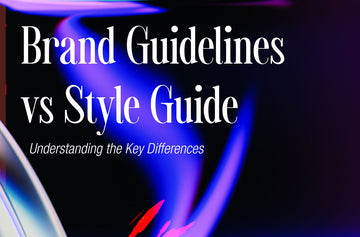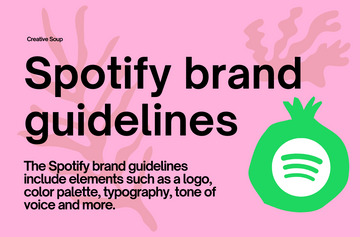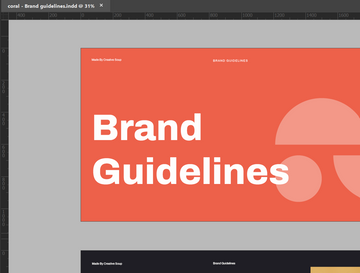When it comes to maintaining a consistent and cohesive brand identity, two essential tools often come into play: brand guidelines and style guides. While the terms are sometimes used interchangeably, they serve distinct purposes in the realm of design and marketing. In this article, we will delve into the differences between brand guidelines and style guides, exploring their components, creation processes, and the ideal scenarios to use each of them.
Introduction
In today's competitive business landscape, establishing a strong brand identity is crucial for success. Brand guidelines and style guides are indispensable resources that ensure brand consistency across various touchpoints. Understanding the distinctions between these two tools is vital for companies and individuals invested in building a recognizable and impactful brand presence.
Understanding Brand Guidelines

Brand guidelines serve as a comprehensive document that outlines the visual and verbal elements of a brand. They provide clear instructions and rules on how to use a brand's logo, typography, color palette, imagery, and tone of voice. Brand guidelines act as a reference manual that enables designers, marketers, and content creators to maintain consistency in all brand-related communications.
Purpose and Benefits of Brand Guidelines
The primary purpose of brand guidelines is to establish a strong and unified brand identity. By defining specific guidelines for visual and verbal elements, brand guidelines ensure that the brand is instantly recognizable and memorable to its target audience. Consistency across all brand touchpoints enhances brand trust and fosters a cohesive brand experience.
The benefits of brand guidelines are manifold. They streamline the design process, as designers have clear instructions on how to represent the brand visually. Brand guidelines also minimize the risk of miscommunication and inconsistency, particularly when multiple teams or external agencies are involved. Additionally, brand guidelines facilitate brand expansion, enabling seamless adaptation across various mediums and channels.
Components of Brand Guidelines

Brand guidelines typically include the following components:
- Brand Story and Mission: A concise overview of the brand's background, values, and objectives.
- Logo Usage: Clear instructions on how to use the logo, including variations, minimum size, spacing, and placement.
- Color Palette: Defined colors and their appropriate usage, ensuring consistency and visual harmony.
- Typography: Guidelines for selecting and using fonts consistently across all brand materials.
- Imagery and Photography: Guidance on the style, tone, and type of imagery that aligns with the brand's aesthetic.
- Voice and Tone: Instructions on the brand's preferred language, tone, and writing style.
- Collateral Design: Guidelines for designing business cards, letterheads, brochures, and other marketing materials.
- Digital Guidelines: Specifications for digital platforms, including website design, social media graphics, and email templates.
- Brand Application Examples: Real-life examples showcasing the correct usage of the brand's visual and verbal elements.
Creating Brand Guidelines
The process of creating brand guidelines begins with thorough research and understanding of the brand's identity, target audience, and market positioning. Collaboration between designers, marketers, and key stakeholders is essential to ensure the guidelines accurately reflect the brand's vision and values.
To create effective brand guidelines, it is crucial to follow these steps:
- Define the Brand: Conduct a comprehensive analysis of the brand's core values, mission, target audience, and unique selling propositions.
- Research and Analyze: Study the market landscape, competitors, and industry trends to identify opportunities and differentiate the brand.
- Visual Elements: Determine the appropriate logo, color palette, typography, and imagery that align with the brand's personality and values.
- Verbal Elements: Develop a distinctive brand voice and tone that resonates with the target audience and reflects the brand's values.
- Collaboration and Review: Involve all relevant stakeholders in the creation process and seek feedback to ensure accuracy and alignment.
- Documentation and Distribution: Compile the brand guidelines into a comprehensive document and distribute it to all individuals and teams involved in brand-related activities.
- Regular Updates: Brand guidelines should be regularly reviewed and updated to accommodate evolving market trends, brand expansions, and shifts in the target audience.
Understanding Style Guide
While brand guidelines focus on visual and verbal elements, a style guide delves deeper into the specifics of content creation. A style guide provides guidelines and rules for creating written content, ensuring consistency in tone, grammar, punctuation, formatting, and other linguistic aspects.
Purpose and Benefits of Style Guide
The primary purpose of a style guide is to establish a consistent and coherent writing style across all brand communications. It ensures that the brand's voice and tone are accurately conveyed, irrespective of the content creator or platform. A style guide acts as a resource for writers, editors, and content strategists, enabling them to maintain a unified and polished written communication style.
The benefits of a style guide include:
- Consistency: It promotes a consistent voice and tone throughout all written materials, fostering a cohesive brand experience.
- Clarity: A style guide provides clear guidelines on grammar, punctuation, and formatting, ensuring clarity and avoiding misinterpretation.
- Efficiency: Writers can refer to the style guide for specific rules and conventions, streamlining the content creation process.
- Brand Perception: A well-defined writing style helps shape the brand's image, positioning it as professional, knowledgeable, and trustworthy.
- Localization: A style guide assists in maintaining consistency when adapting content for different regions or languages.
Components of Style Guide
A style guide typically includes the following components:
- Grammar and Punctuation: Guidelines for grammatical rules, punctuation usage, and common errors to avoid.
- Formatting and Structure: Rules for headings, subheadings, paragraphs, lists, and other formatting elements.
- Voice and Tone: Instructions on the preferred writing style, tone, and linguistic preferences.
- Word Usage and Vocabulary: Guidelines for choosing appropriate words, jargon, and industry-specific terminology.
- Citations and References: Standards for citing sources and referencing external material.
- Inclusive Language: Guidelines for using inclusive and gender-neutral language to ensure a diverse and inclusive brand image.
- Editorial Guidelines: Instructions on proofreading, fact-checking, and editing processes.
- Preferred Style Manual: Recommendations on using a specific style manual, such as APA, MLA, Chicago Manual of Style, etc.
Creating Style Guide
Developing a style guide requires careful consideration of the brand's target audience, industry, and preferred writing style. Collaboration between writers, editors, and content strategists is essential to establish a style guide that aligns with the brand's voice and reflects its values.
To create an effective style guide, consider the following steps:
- Define the Brand's Voice: Determine the desired tone, style, and linguistic preferences that reflect the brand's personality and values.
- Choose a Style Manual: Select a recognized style manual that aligns with the brand's communication goals and industry standards.
- Grammar and Formatting Guidelines: Establish clear rules for grammar, punctuation, capitalization, and formatting.
- Writing Style: Define the brand's preferred writing style, including sentence structure, vocabulary, and tone.
- Content Structure: Provide guidelines for structuring content, including headings, subheadings, paragraphs, and lists.
- Inclusive Language: Ensure guidelines for using inclusive and gender-neutral language to promote diversity and inclusivity.
- Citations and References: Specify rules for citing sources, referencing external material, and maintaining accuracy.
- Editorial Processes: Outline the editorial processes, including proofreading, fact-checking, and editing guidelines.
Brand Guidelines vs. Style Guide: Key Differences
Although brand guidelines and style guides share the common goal of maintaining consistency, they differ in their focus and scope. Brand guidelines primarily concentrate on visual and verbal elements, ensuring consistent brand identity across various mediums. On the other hand, style guides primarily address the written content, guiding writers to maintain a consistent and coherent writing style.
When to Use Brand Guidelines:
- Brand guidelines are essential when establishing a new brand or undergoing a brand identity redesign.
- They are crucial for maintaining visual consistency across various touchpoints, such as websites, marketing materials, and product packaging.
- Brand guidelines are especially important when working with multiple designers or agencies to ensure a cohesive brand representation.
When to Use Style Guide:
- Style guides are necessary for maintaining a consistent writing style across all brand communications.
- They are particularly valuable for content creators, editors, and writers to ensure uniformity in tone, grammar, and formatting.
- Style guides are beneficial for companies with frequent content creation needs, such as blogs, social media platforms, and marketing campaigns.
Conclusion
In conclusion, brand guidelines and style guides are indispensable tools for maintaining brand consistency and creating impactful brand experiences. Brand guidelines focus on visual and verbal elements, while style guides delve into the specifics of written content. By adhering to both brand guidelines and style guides, organizations can establish a unified and recognizable brand identity, enhancing brand perception and fostering customer trust.
FAQs
1. Are brand guidelines and style guides the same thing?
No, brand guidelines and style guides serve different purposes. Brand guidelines focus on visual and verbal elements, ensuring consistent brand identity, while style guides provide guidelines for written content, maintaining a consistent writing style.
2. Can I use brand guidelines without a style guide?
While it is possible to use brand guidelines without a style guide, incorporating both ensures consistency in both visual and written brand communications, leading to a more cohesive brand experience.
3. How often should brand guidelines and style guides be updated?
Brand guidelines and style guides should be regularly reviewed and updated to accommodate changes in market trends, brand expansions, and shifts in the target audience.
4. Are brand guidelines and style guides only for large corporations?
No, brand guidelines and style guides are valuable for organizations of all sizes. They help establish a consistent and professional brand identity, regardless of the company's scale.
5. Can brand guidelines and style guides be used in digital marketing?
Absolutely! Brand guidelines and style guides play a vital role in digital marketing, ensuring consistent brand representation across websites, social media platforms, email marketing, and other digital channels.








